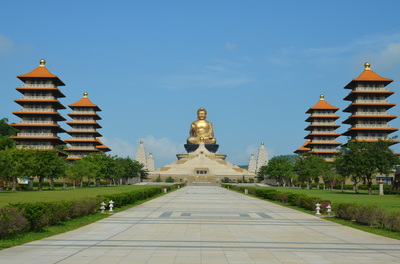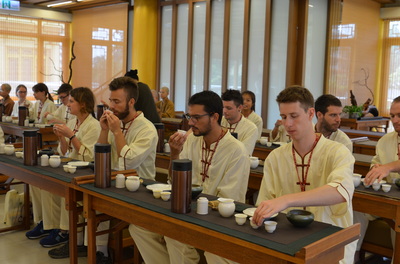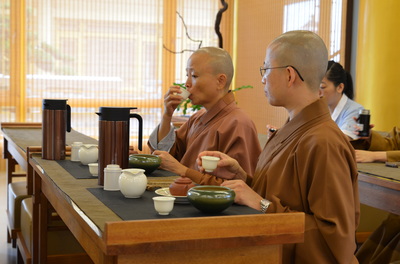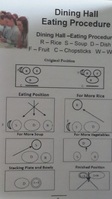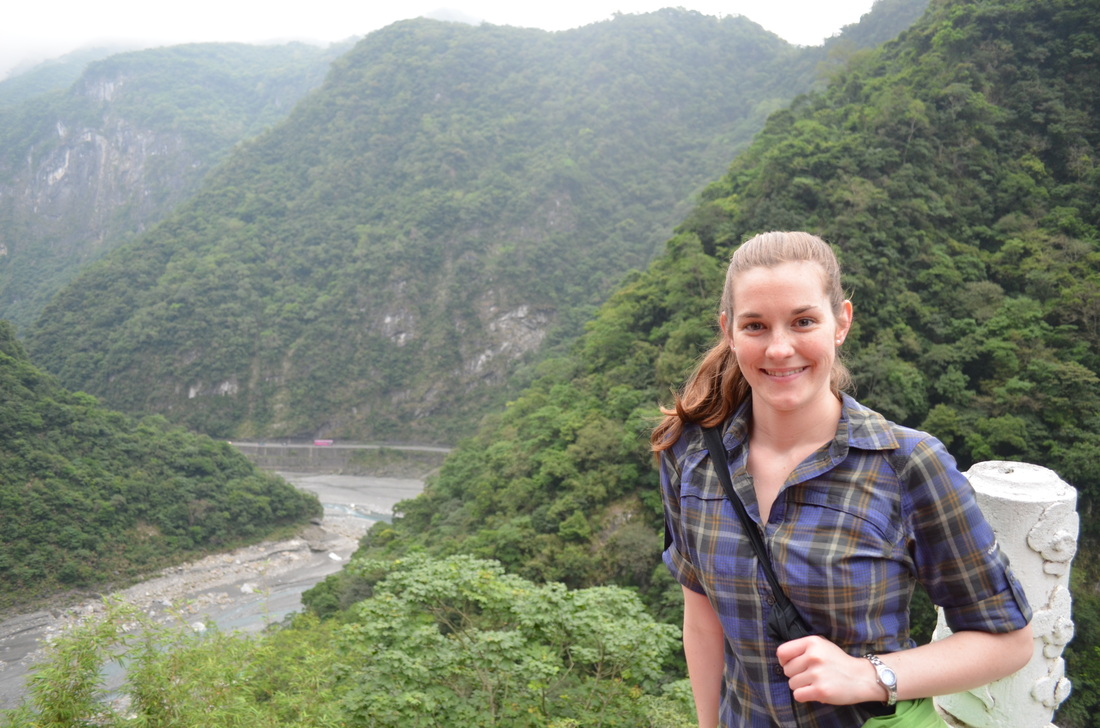I arrived at the Fo Guang Shan Monastery just 5 minutes before registration closed. I was given my robes and told to quickly dress. In my mind this meditation retreat was going to involve roughing it. It was far from rough. Our rooms were very comfortable with only three people per room in an almost hotel setting.
Orientation took over an hour and mainly taught us monastery etiquette. We learned how to bow in respect of the Buddha and how to properly eat. One of my favorite parts of the whole experience was the meal time process. Yes, I loved the vegetarian fare, but it was more than the food. We would line up in silence and at the sounding of a gong we would enter the dining hall along with hundreds of venerables (monks/nuns). Silence was of the upmost importance. Before we sat, we would bow to the Buddha and chant as a group. This was basically the equivalent of Christians saying, “Dear Lord please give this food to the nourishment of my body…” Once seated we would decide if there was anything we didn’t want or if we wanted less of something. If that was the case, we would leave that dish at the edge of the table and an attendant would quickly remove the item (all of this was in silence). We would then pull the main dish towards ourselves. Then the rice dish would be taken from the left of the plate to the right of the plate and the soup dish from the right to the left. If you wanted water, you would finish your soup and place your bowl at 10 o’clock. The whole process took 15-20 minutes tops. The hardest part was the speed. Many of my fellow newbies struggled to eat fast enough and also struggled to eat everything. Those who left food behind on their plate were firmly spoken to in front of the whole group. Since the food is solely from donations waste is unacceptable. Eating in this way had many purposes. The main one being that it forced you to be present minded while eating. When you are presently minded, you are able to gauge your stomach and prevent yourself from overeating or wasting food. Also, it can be a time of mindful meditation. I recommend trying to eat a meal without the TV and without any form of distraction. It really is a pleasant experience and makes consuming food more about giving your body the proper nutrition than mechanically putting something into your stomach. (Above is a picture of the eating etiquette)
The group was a nice distribution of nationalities. There were 5 Americans, 6 Germans, 2 Swedes, 2 Australians, 1 Czech, 1 Paraguayan, and 2 French. Everyone was between 22 and 29. We all clicked very well and enjoyed chatting, warrant we didn’t have a lot of time where we could talk. A lot of our time was meant to be in silence. One thing I really enjoyed was each person was either working or teaching in Taiwan, so we all had a pretty good knowledge base about Taiwan and its culture.
Each day we would wake up at 5:00 and were expected to be in line by 5:15. We would all walk up to the main temple for morning chanting (5:50-6:30am). An interesting misconception about Buddhism is the thought that Buddhists worship the Buddha (Please keep in mind I do not claim to be an expert on Buddhism and I mean no disrespect if what I say is inaccurate). When you see a Buddhist bow and “pray” to a Buddha statue, they are not worshiping the statue as if worshiping a god. I think this idea of idol worshipping often makes westerners uncomfortable. In reality the Buddha statue is seen as a symbol for what you yourself can achieve. Buddhas are not gods. Buddhas are people like us who have achieved enlightenment over many life cycles. In Christianity if you do not follow a good life and make certain decisions, you go to hell. In Buddhism karma decides how you come back in your next life. Thus, we were not praying to Buddha we were just showing him respect. Now there are many Buddhas because more than one person has achieved enlightenment (male and female). When people think of Buddha, often times they are thinking of the original Buddha Shakyamuni or Sakyamuni. He lived in the 7th/6th century B.C. His name was Prince Siddhartha and he had everything. He had a beautiful wife, a healthy son, and a lot of wealth. One day he went out into his kingdom and witnessed suffering. He wanted to know the cause and cure of suffering. This bothered him for some time until he finally just left everything behind to find answers to is questions. He starved himself and lived a pauper. After years of hardship, while sitting underneath a banyan tree he became enlightened. He then spent the rest of his life preaching and teaching others how to follow this path. In my understanding a boiled down way of explaining his teachings is remove attachment to earthly things and calm your mind through meditation and mindfulness, to achieve tranquility and peace. I really respect the tenants of Buddhism. It mainly teaches compassion and kindness.
With the above in mind, I must correct what I stated in my previous post about Buddhism having a god for every need you may have. The many temples I have visited with my Taiwanese friends are not actually Buddhist. These temples are an odd mix of Buddhism and Taoism, with a much stronger Taoist leaning. At these temples you can pray to gods for specific problems and throw red blocks. If one red block lands face up and the other down three times, it means you may ask the gods a question. Then the yes or no answer depends on how the blocks fall the next time you throw them. Anyway, all of this is not Buddhism, but Taoism.
After chanting we would have our speedy breakfast and then an hour of chores. We were given several in depth tours. The grounds are supposed to resemble the Forbidden City in Beijing. It was really amazing. There are two parts to the complex. The area where the venerables live and work is serene and authentic. The new Buddha Memorial Hall feels like a mall and a disturbing money making machine. There is even a Starbucks. I AM NOT KIDDING. I really didn’t like this aspect of the place. It is even worse than when I first went to St. Peters in Rome. I love St. Peters, but it definitely drips power and money. Especially considering the history of the Catholic Church’s corruption and abuse of power, this doesn’t settle well with me. Fo Guang Shan has a lot of funding and many branches all over the world.
The rest of our days were divided nicely between very unique activities. We spent two hours working on Sutra Calligraphy. This was AWESOME. The purpose is to focus your mind and to think about nothing. In essence it is another form of meditation. While we were working, it was raining outside and the bamboo trees were dripping with water. It felt very mystical and made the whole day feel special. It definitely made me realize why I love school so much. I love the feeling of sitting down and focusing on homework/studying. You have a purpose and you are progressing towards something instead of idly passing time. We also spent time each day in the meditation hall. I recommend beginners to try sitting quietly for ten minutes a day. Research shows it can decrease stress, increase blood flow to the brain, and can greatly improve health. We had an introduction to Buddhism class, a Q&A class, and a class on Chan meditation (meditation through drinking tea). The latter was my favorite. The class took place in a gold pagoda. The setting was so tranquil and we each had our own individual tea set. The instructor taught us how to properly walk ourselves through a whole tea ceremony. We made tea and shared it with our neighbors. I was only allowed to have my camera the last day. Everyone was so impressed by the lens my brother bought me, thus they dubbed me the official documenter of the trip and the venerables even allowed me to take photos during the tea class.
There is so much more to share, but for the sake of not over sharing I will leave you with just my overall impressions. It was an insightful experience and definitely encouraged me to practice mindfulness on a daily basis. As the master in Kung Fu Panda stated, “Yesterday is history. Tomorrow is a mystery. And today is a gift that is why it is called the present.”
P.S. Make sure to check out the Jump with Me tab. I will be updating it frequently moving forward.
Orientation took over an hour and mainly taught us monastery etiquette. We learned how to bow in respect of the Buddha and how to properly eat. One of my favorite parts of the whole experience was the meal time process. Yes, I loved the vegetarian fare, but it was more than the food. We would line up in silence and at the sounding of a gong we would enter the dining hall along with hundreds of venerables (monks/nuns). Silence was of the upmost importance. Before we sat, we would bow to the Buddha and chant as a group. This was basically the equivalent of Christians saying, “Dear Lord please give this food to the nourishment of my body…” Once seated we would decide if there was anything we didn’t want or if we wanted less of something. If that was the case, we would leave that dish at the edge of the table and an attendant would quickly remove the item (all of this was in silence). We would then pull the main dish towards ourselves. Then the rice dish would be taken from the left of the plate to the right of the plate and the soup dish from the right to the left. If you wanted water, you would finish your soup and place your bowl at 10 o’clock. The whole process took 15-20 minutes tops. The hardest part was the speed. Many of my fellow newbies struggled to eat fast enough and also struggled to eat everything. Those who left food behind on their plate were firmly spoken to in front of the whole group. Since the food is solely from donations waste is unacceptable. Eating in this way had many purposes. The main one being that it forced you to be present minded while eating. When you are presently minded, you are able to gauge your stomach and prevent yourself from overeating or wasting food. Also, it can be a time of mindful meditation. I recommend trying to eat a meal without the TV and without any form of distraction. It really is a pleasant experience and makes consuming food more about giving your body the proper nutrition than mechanically putting something into your stomach. (Above is a picture of the eating etiquette)
The group was a nice distribution of nationalities. There were 5 Americans, 6 Germans, 2 Swedes, 2 Australians, 1 Czech, 1 Paraguayan, and 2 French. Everyone was between 22 and 29. We all clicked very well and enjoyed chatting, warrant we didn’t have a lot of time where we could talk. A lot of our time was meant to be in silence. One thing I really enjoyed was each person was either working or teaching in Taiwan, so we all had a pretty good knowledge base about Taiwan and its culture.
Each day we would wake up at 5:00 and were expected to be in line by 5:15. We would all walk up to the main temple for morning chanting (5:50-6:30am). An interesting misconception about Buddhism is the thought that Buddhists worship the Buddha (Please keep in mind I do not claim to be an expert on Buddhism and I mean no disrespect if what I say is inaccurate). When you see a Buddhist bow and “pray” to a Buddha statue, they are not worshiping the statue as if worshiping a god. I think this idea of idol worshipping often makes westerners uncomfortable. In reality the Buddha statue is seen as a symbol for what you yourself can achieve. Buddhas are not gods. Buddhas are people like us who have achieved enlightenment over many life cycles. In Christianity if you do not follow a good life and make certain decisions, you go to hell. In Buddhism karma decides how you come back in your next life. Thus, we were not praying to Buddha we were just showing him respect. Now there are many Buddhas because more than one person has achieved enlightenment (male and female). When people think of Buddha, often times they are thinking of the original Buddha Shakyamuni or Sakyamuni. He lived in the 7th/6th century B.C. His name was Prince Siddhartha and he had everything. He had a beautiful wife, a healthy son, and a lot of wealth. One day he went out into his kingdom and witnessed suffering. He wanted to know the cause and cure of suffering. This bothered him for some time until he finally just left everything behind to find answers to is questions. He starved himself and lived a pauper. After years of hardship, while sitting underneath a banyan tree he became enlightened. He then spent the rest of his life preaching and teaching others how to follow this path. In my understanding a boiled down way of explaining his teachings is remove attachment to earthly things and calm your mind through meditation and mindfulness, to achieve tranquility and peace. I really respect the tenants of Buddhism. It mainly teaches compassion and kindness.
With the above in mind, I must correct what I stated in my previous post about Buddhism having a god for every need you may have. The many temples I have visited with my Taiwanese friends are not actually Buddhist. These temples are an odd mix of Buddhism and Taoism, with a much stronger Taoist leaning. At these temples you can pray to gods for specific problems and throw red blocks. If one red block lands face up and the other down three times, it means you may ask the gods a question. Then the yes or no answer depends on how the blocks fall the next time you throw them. Anyway, all of this is not Buddhism, but Taoism.
After chanting we would have our speedy breakfast and then an hour of chores. We were given several in depth tours. The grounds are supposed to resemble the Forbidden City in Beijing. It was really amazing. There are two parts to the complex. The area where the venerables live and work is serene and authentic. The new Buddha Memorial Hall feels like a mall and a disturbing money making machine. There is even a Starbucks. I AM NOT KIDDING. I really didn’t like this aspect of the place. It is even worse than when I first went to St. Peters in Rome. I love St. Peters, but it definitely drips power and money. Especially considering the history of the Catholic Church’s corruption and abuse of power, this doesn’t settle well with me. Fo Guang Shan has a lot of funding and many branches all over the world.
The rest of our days were divided nicely between very unique activities. We spent two hours working on Sutra Calligraphy. This was AWESOME. The purpose is to focus your mind and to think about nothing. In essence it is another form of meditation. While we were working, it was raining outside and the bamboo trees were dripping with water. It felt very mystical and made the whole day feel special. It definitely made me realize why I love school so much. I love the feeling of sitting down and focusing on homework/studying. You have a purpose and you are progressing towards something instead of idly passing time. We also spent time each day in the meditation hall. I recommend beginners to try sitting quietly for ten minutes a day. Research shows it can decrease stress, increase blood flow to the brain, and can greatly improve health. We had an introduction to Buddhism class, a Q&A class, and a class on Chan meditation (meditation through drinking tea). The latter was my favorite. The class took place in a gold pagoda. The setting was so tranquil and we each had our own individual tea set. The instructor taught us how to properly walk ourselves through a whole tea ceremony. We made tea and shared it with our neighbors. I was only allowed to have my camera the last day. Everyone was so impressed by the lens my brother bought me, thus they dubbed me the official documenter of the trip and the venerables even allowed me to take photos during the tea class.
There is so much more to share, but for the sake of not over sharing I will leave you with just my overall impressions. It was an insightful experience and definitely encouraged me to practice mindfulness on a daily basis. As the master in Kung Fu Panda stated, “Yesterday is history. Tomorrow is a mystery. And today is a gift that is why it is called the present.”
P.S. Make sure to check out the Jump with Me tab. I will be updating it frequently moving forward.
